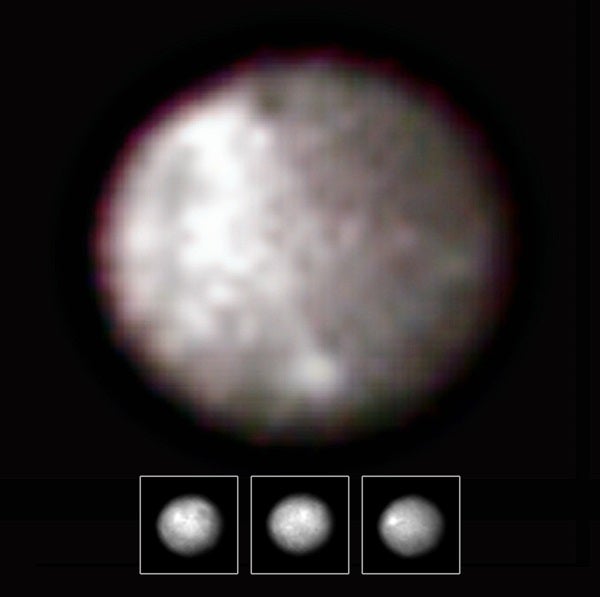September 12, 2005
   These animations show Ceres through one full rotation as seen by the Hubble Space Telescope in mid- and near-ultraviolet (top and center) and visible wavelengths (bottom). J. Parker, SWRI |
Located near the middle of the main asteroid belt between Mars and Jupiter, Ceres is the largest such body at about 592 miles (952 kilometers) across. Despite its size, this asteroid has a rather bland reputation among astronomers: Its low density, low reflectivity (albedo), and relatively featureless spectrum have led scientists to conclude the asteroid’s interior is uniform in composition, with little structure. However, a paper published in the journal Nature provides strong evidence that Ceres may be far more complex.
A team of astronomers led by Peter Thomas of Cornell University used the Hubble Space Telescope to obtain images of Ceres in December 2003 and January 2004. Measurements of the asteroid’s shape revealed Ceres is rotationally symmetric — the distance from the asteroid’s surface to its center is the same regardless of longitude.
This indicates Ceres’ shape is determined by hydrostatic equilibrium, in which the weight of the overlying material determines the pressure at any point within the body. Stars like the Sun, as well as planets — both gas giants like Jupiter and rocky bodies like Earth — are in global hydrostatic equilibrium. Otherwise, their sizes would not remain constant.
“This is the first time we have seen Ceres in such detail and can even say something about its interior,” says team member Joel Parker of the Southwest Research Institute in San Antonio, Texas. “You can watch it rotate in our observations, and you get the feeling of it being a whole new world, not just a bit of rocky debris.”
Some astronomers, notably team member Alan Stern, also of SWRI, think a shape determined by global hydrostatic equilibrium is part of what distinguishes planets from asteroids. If we accept this argument, Ceres is a planet.
Measurements of the asteroid’s shape also provide information about its interior. The equatorial region of any body that spins fast enough bulges outwards. Instead of looking like a perfect sphere, the star or planet (or asteroid, in the case of Ceres) looks “flattened.” By measuring the distances from the body’s center to its equator and poles, scientists can determine the amount of flattening, which constrains the interior’s possible structure.
Ceres has a mean density of about 2.077 grams per cubic centimeter (roughly twice that of water), and a uniform body of this density should have a polar radius about 23.8 miles (39.7 km) smaller than the equatorial radius. Ceres’ polar radius is only 19.6 miles (32.6 km) smaller. This is strong evidence its interior consists of different layers. In fact, the smaller amount of flattening indicates the presence of a mantle and a core.
The team developed computer models of Ceres’ interior using available data on the asteroid. Their findings: Ceres has a rocky core and could have an icy mantle as thick as 77 miles (124 km), amounting to about one quarter of its mass. The lack of a water signature in the asteroid’s spectrum does not present a problem, as any water ice on Ceres’ surface would be unstable and soon lost to space.
The astronomers make a bold prediction in their Nature paper: They assert NASA’s Dawn spacecraft, upon its arrival at Ceres, will find a “globally relaxed and differentiated object, but which should retain a visible cratering record, and possible tectonic features.” We will have to wait until 2015 to find out if they are right.










